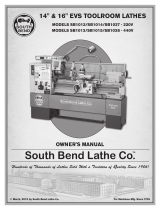King Canada KC-1236ML/KM-053 User manual
- Category
- Lathes
- Type
- User manual
This manual is also suitable for
King Canada KC-1236ML/KM-053 is a versatile metal lathe with a 12" swing over bed and a 36" distance between centers, making it suitable for a wide range of metalworking projects. Its variable spindle speeds from 60 to 1500 RPM and 9-speed gearbox allow for precise control over cutting speeds, while the MT#5 spindle taper and 1-1/2" spindle bore diameter accommodate a variety of tooling. The lathe also features a sturdy cast iron bed and headstock for stability, along with a quick-change tool post for efficient tool changes.
King Canada KC-1236ML/KM-053 is a versatile metal lathe with a 12" swing over bed and a 36" distance between centers, making it suitable for a wide range of metalworking projects. Its variable spindle speeds from 60 to 1500 RPM and 9-speed gearbox allow for precise control over cutting speeds, while the MT#5 spindle taper and 1-1/2" spindle bore diameter accommodate a variety of tooling. The lathe also features a sturdy cast iron bed and headstock for stability, along with a quick-change tool post for efficient tool changes.













-
 1
1
-
 2
2
-
 3
3
-
 4
4
-
 5
5
-
 6
6
-
 7
7
-
 8
8
-
 9
9
-
 10
10
-
 11
11
-
 12
12
-
 13
13
King Canada KC-1236ML/KM-053 User manual
- Category
- Lathes
- Type
- User manual
- This manual is also suitable for
King Canada KC-1236ML/KM-053 is a versatile metal lathe with a 12" swing over bed and a 36" distance between centers, making it suitable for a wide range of metalworking projects. Its variable spindle speeds from 60 to 1500 RPM and 9-speed gearbox allow for precise control over cutting speeds, while the MT#5 spindle taper and 1-1/2" spindle bore diameter accommodate a variety of tooling. The lathe also features a sturdy cast iron bed and headstock for stability, along with a quick-change tool post for efficient tool changes.
Ask a question and I''ll find the answer in the document
Finding information in a document is now easier with AI
Related papers
-
King Canada KC-1440ML-6 User manual
-
King Canada KC-1440ML User manual
-
King Canada KC-1440ML-2/KM-054 User manual
-
King Canada KC-1022ML User manual
-
King Canada KC-1022ML User manual
-
King Canada KC-1440ML-2/KM-054 User manual
-
King Canada KC-0712ML User manual
-
King Canada KC-1640ML User manual
-
King Canada KC-1640ML User manual
-
King Canada KC-1620CLM User manual
Other documents
-
Harbor Freight Tools Item 93799 Owner's manual
-
Grizzly G0782 Owner's manual
-
Grizzly G0750G Owner's manual
-
Grizzly G0776 Owner's manual
-
Grizzly G0750GV Owner's manual
-
Grizzly G4003G Owner's manual
-
Grizzly G0824 Owner's manual
-
Southbend SB1012 User manual
-
Jet Tools GH-1340W User manual
-
 South bend SB1014 Owner's manual
South bend SB1014 Owner's manual













